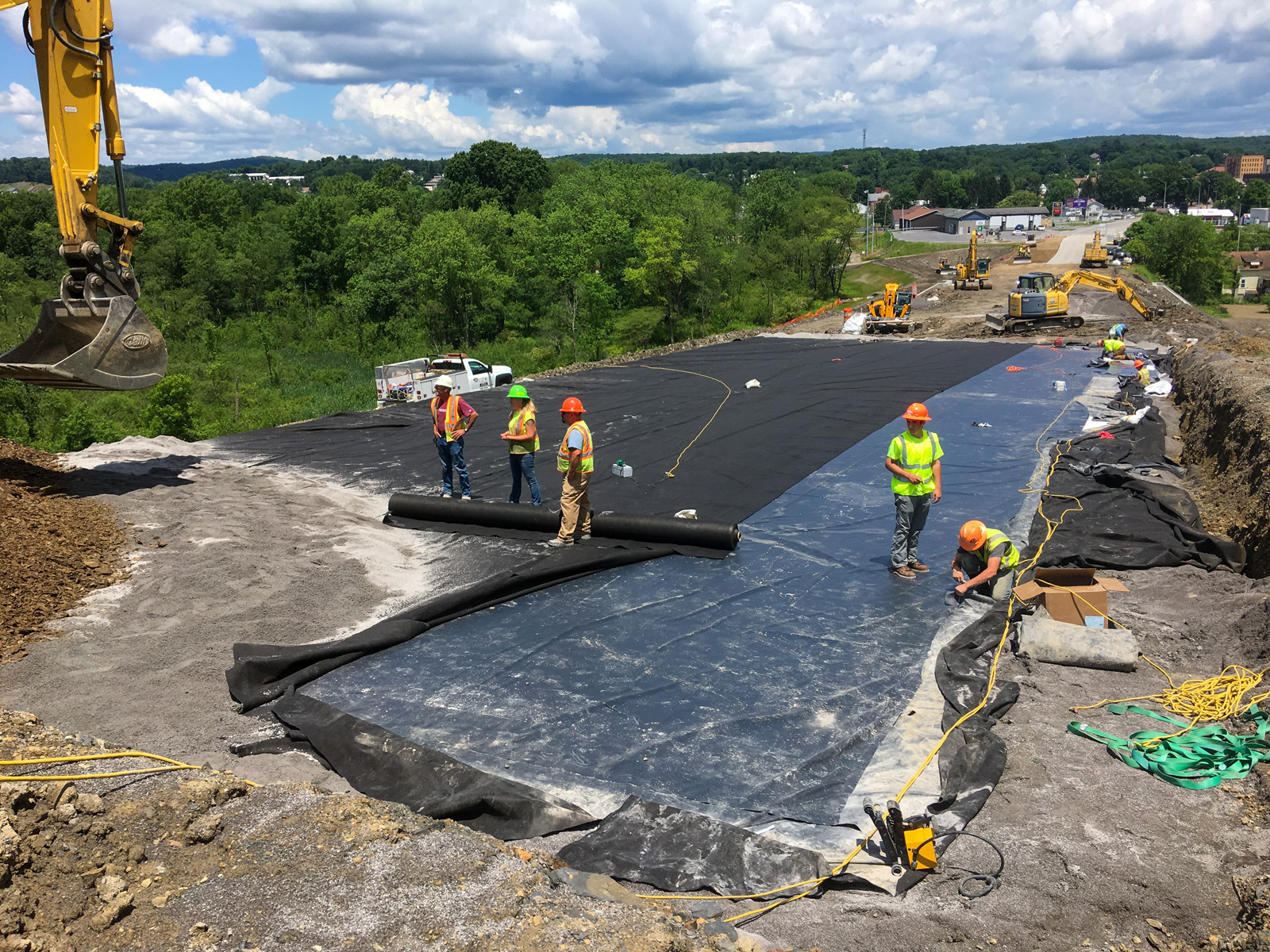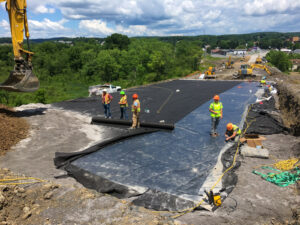Geomembranes are critical in protecting soil and water from contamination for broad categories of industry such as environmental management, construction, agriculture, and mining. Geomembranes serve as impermeable barriers in applications from landfills and wastewater ponds to secondary containment and tailings storage. When installed and maintained correctly, geomembranes give decades of reliable service. However, when geomembrane failures occur, they will compromise entire systems and lead to environmental damage, costly repairs, and regulatory repercussions.
When understanding the causes of geomembrane failures and applying best practices, decision-makers do better at preventing problems and maximizing performance. At E Squared, we combine advanced materials with technical expertise to provide solutions that reduce risks and ensure geomembrane durability across industries.
Why Geomembrane Failures Matter
Geomembrane failures go beyond material defects; they often result from complex interactions between design, site conditions, installation practices, and ongoing maintenance. A compromised liner can lead to:
- Exposure to not compatible materials that were not tested by the geomembrane supplier prior to installation
- Groundwater contamination from hazardous leachate or wastewater seepage.
- Regulatory fines under EPA or state agency enforcement.
- Increased remediation costs that far exceed the cost of original liner installation.
- Operational disruptions in mining, construction, and environmental projects.
For engineers, contractors, and facility managers, preventing failure is not only about compliance, but it also safeguards long-term project success.
Common Causes of Geomembrane Failures and How to Prevent Them
1. Poor Installation Practices
Some of the leading contributors to geomembrane failures is improper fabrication and installation. While geomembrane sheets are engineered to be impermeable, flawed handling in the field might introduce weaknesses.
Typical Installation Mistakes Include:
- Wrinkles and bridging caused by inadequate panel placement.
- Faulty welding and seams that fail under pressure.
- Damage from heavy equipment or sharp objects during installation.
- Insufficient anchor trenches or poor subgrade preparation.
Mitigation Strategies:
- Employ trained and certified installers.
- Use quality-controlled seaming methods such as wedge or hot air welding.
- Be sure your seam overlap widths are adequate for the load the geomembranes will be required to handle. E Squared recommends a minimum overlap weld of 2 inches.
- Conduct continuous inspection and post-installation air testing of seams.
- Prepare subgrades with geotextile cushioning to prevent punctures.
E Squared offers support to partners with guidance on field preparation and seam testing to minimize the risk of installation-related issues.
2. Inadequate Material Selection
Not all geomembranes are created equal. Choosing the wrong material for the chemical or physical demands of a project is sure to lead to premature failure.
Examples of Material-Related Failures:
- Use of HDPE geomembrane in highly flexible or complex installations where LLDPE would perform better.
- Exposure of liners to aggressive chemicals not suited for the polymer type.
- Overlooking elongation, deadload or stress crack resistance requirements.
How to Prevent:
- Match geomembrane material to the specific application’s environmental and operational demands.
- Always consider chemical compatibility, expected loading forces, and temperature fluctuations.
- Engage with manufacturers like E Squared to assess the right product from available Products.
By aligning material choice with project needs, operators avoid failures linked to polymer mismatch.
3. Seam Weaknesses
Seams represent one of the most vulnerable points in any geomembrane installation. Improperly bonded seams or insufficient testing leads to leakage. E Squared recommends a minimum overlap weld of 2 inches.
Failure Signs Include:
- Delamination under hydrostatic pressure.
- Reduced tensile strength causing separation.
- Untested seams developing leaks after backfilling or fluid exposure.
Mitigation Approaches:
- Use standardized, industry-approved welding equipment and qualified welders.
- Employ dual-track fusion welding with air-channel testing for critical applications.
- Conduct destructive seam testing to verify bond strength.
- Document all quality assurance and quality control processes to meet regulatory requirements.
E Squared’s geomembranes are engineered with seamability in mind. Our goal is reduced risk.
4. Punctures and Mechanical Damage
Construction sites and industrial operations pose hazards that physically damage liners. Punctures, tears, and abrasion during transportation and on site are common causes of geomembrane failures.
Sources of Mechanical Damage Include:
- Rocks, debris, or sharp objects in the subgrade.
- Heavy equipment traffic during installation.
- Animal activity or vandalism post-installation.
How to Prevent:
- Place protective geotextiles under and over liners.
- Enforce traffic restrictions in liner areas.
- Regularly inspect exposed liners for damage.
- Consider reinforced geomembranes for high-risk projects.
Proactive steps to safeguard against punctures drastically improve geomembrane durability.
5. UV Degradation and Weathering
When geomembranes are exposed to prolonged sunlight, especially in arid and high-elevation sites, ultraviolet (UV) radiation causes polymer breakdown.
Indicators of UV damage include:
- Brittleness and loss of flexibility.
- Cracking or chalking on the surface.
- Reduction in mechanical strength over time.
Prevention strategies:
- Use geomembranes with built-in UV stabilizers in exposed applications.
- Cover exposed liners with protective soil, ballast, or geotextile layers.
- Rotate or phase project installations to limit material exposure before covering.
E Squared products include advanced formulations with enhanced stabilization for UV resistance to extend service life even under challenging site conditions.
6. Chemical Exposure and Material Degradation
Industrial and mining projects often involve acidic leachates, hydrocarbons, or solvents that chemically compromise liners. Incompatible geomembranes swell, soften, or lose impermeability.
Failure Examples:
- Industrial chemicals permeating polymers.
- Exposure to high concentrations of hydrocarbons or solvents.
How to Prevent:
- Perform laboratory compatibility testing before selection.
- Consult with E Squared to evaluate polymer resistance.
- Choose specialized materials designed for harsh environments.
E Squared offers geomembranes with superior chemical resistance that are ideal for mining and industrial wastewater applications.
7. Lack of Ongoing Maintenance
Even well-designed systems require maintenance. Neglecting inspections or performing poor ones allows small defects to grow into major failures.
Risks include:
- Minor tears that expand under hydrostatic pressure.
- Unchecked vegetation growth damaging liners.
- Animal burrows undermining containment integrity.
Best practices for maintenance:
- Implement scheduled inspection programs.
- Repair all defects promptly with compatible patches or welding.
- Train facility staff to identify threats and early warning signs.
Preventative maintenance adds significantly to long-term containment performance.
Best Practices for Geomembrane Success
Preventing failure relies on a holistic approach across design, installation, and maintenance. Core geomembrane best practices include:
- Partner with experienced manufacturers like E Squared for material selection.
- Employ certified installers and enforce QA/QC during fieldwork.
- Protect liners with geotextile, soil, or ballast covers.
- Select materials with proven UV and chemical resistance.
- Commit to regular inspections and rapid repairs.
Following these geomembrane mitigation strategies reduces project risks.
Partner with E Squared to Prevent Geomembrane Failures
Preventing geomembrane failures requires both knowledge and the right materials. At E Squared, we design high-performance liners that combine durability, chemical resistance, and ease of installation to minimize risks. Our technical experts work alongside engineers and contractors to provide sustainable, project-specific solutions.
Explore more on our Applications page to see how geomembranes are used across industries, or visit our Products to review material options engineered to resist failures. Looking for tailored guidance? Contact Us today to discuss your project.
For additional insights on geomembrane performance and innovation, explore the E Squared Blog.
Frequently Asked Questions
What are the most common causes of geomembrane failures?
Installation errors, punctures, material incompatibility, seam weaknesses, UV degradation, and chemical exposure are the primary culprits.
How can installation errors lead to geomembrane failures?
Poor welding, subgrade preparation, or poor handling practices introduce defects that undermine the liner’s impermeability.
What role does material selection play in preventing failures?
Choosing the right geomembrane ensures compatibility with the chemical and physical environment, increasing long-term durability.
How do you repair failed geomembranes?
Repairs often use welding techniques or compatible patching materials. Major failures require consultation with the manufacturer and the use of certified repair crews.
What steps should be taken to extend the lifespan of a geomembrane?
Protect liners from UV exposure, inspect them regularly, prevent punctures, and use materials tailored to the specific waste stream.


